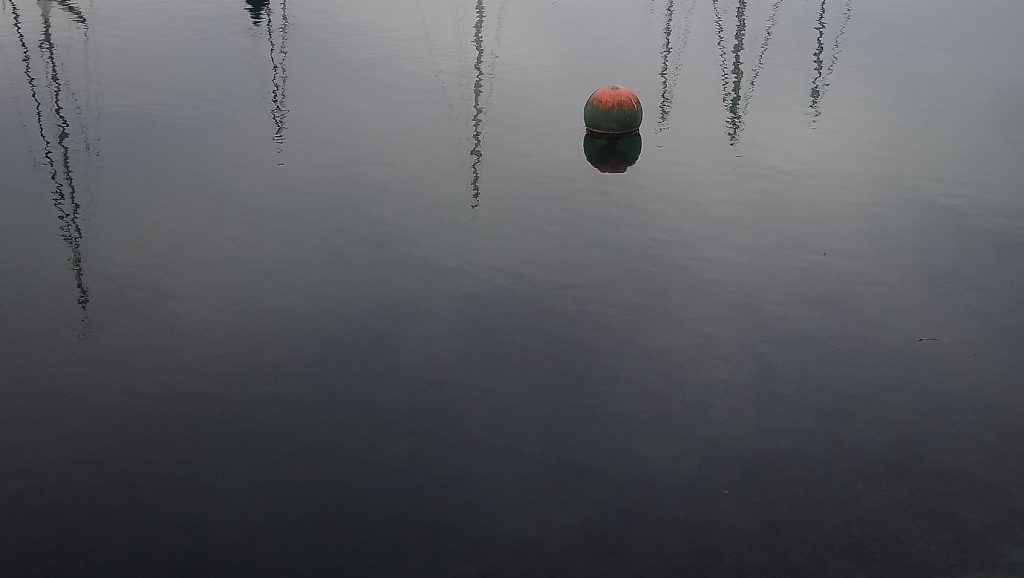Maruška Svašek
Reader in Anthropology
Bangor, 09/04/2020

Since the lockdown two weeks ago, I have made a few new friends. I meet them on my early morning walks, or late in the afternoon, when the sun hangs low in the sky. They live within a two-mile radius of my house, but it is only now, at this time of enforced isolation, that they have managed to draw my attention.
My best new pal is round and colourful – a splash of orange contrasts with a layer of green algae. I first spotted her about ten days ago as I slowly walked past the Marina. It was getting dark and her bright skin flashed against the blue-grey background.
I stared. She floated quietly, her shadow a silent companion.
The next morning, I returned and sought her out. The surface of the water was now eerily still. She looked at me, mocking. ‘I know’, I said, I can’t get to you, the water is too deep’. She waited in silence.
‘But you have your limitations too’, I added, ‘there is a world down there that you cannot reach’.

Two days later, I checked up on her once again. She was waiting impatiently, close to the shore, moving up-down-up-down on tiny waves. ‘You’re right, she said, and briefly paused. ‘But overcoming distance has been your problem, not mine’.

Reflection
The short story reflects my interest in the affective dynamics of people and things, a topic that I have explored in various writings (see for example, Komarova and Svašek 2018; Svašek 2012, 2016 2019, forthcoming; Svašek and Meyer 2016). Its perspective builds on the framework of transit, transition and transformation that I developed in Moving Subjects, Moving Objects. Transnationalism, Cultural Production and Emotions (Svašek 2012). The book investigated how mobile human beings experience and project notions of self and sociality as they produce and use specific material objects, and analyses how the meanings, values and efficacy of the objects change. In other work, I have argued that human and non-human phenomena exist as dynamic affective relations, as forces with impact in multiple modes and directions. Artefacts, in other words, can forcefully enter the life worlds of individuals, for example when a person falls over a chair, or a bright colour catches the eye of a passer-by. The impact is often related to culturally specific expectations. Different consumer groups can feel bedazzled by expensive jewellery, the latest I-phone, or a work by a famous artist. A statue of Ganesh or Mary can evoke strong feelings of devotion and hope.
Material objects, however, are not human beings. While it is useful to consider the workings of physical and material intensities within a single analytical framework, a distinction between human and non-human actants must be maintained. After all, things have a quality that mortal bodies lack: they can survive their makers. In addition, the creation, alteration, removal, and destruction of artefacts relies on human activity.
The story blurs this boundary between human and object agency. I did not choose to animate the buoy because I heard it speak, or because I imagined a voice when taking the photographs. Its female appearance and her spoken words emerged as I was writing.
The narrative twist, evoking human-like presence, intended to express a sense of longing for company at the time of the pandemic. It also explored the ways in which I am newly attuning to a familiar landscape, as the lockdown situation has forced me to walk the same walk, day in, day out, without a chance to meet up face-to-face, with friends and colleagues.
The writing process seems to be a third partner in the emerging affective field.
References
Komarova, M. and M. Svašek (eds) 2018 Ethnographies of Movement, Sociality and Space. Place-making in the New Northern Ireland Oxford: Berghahn.
— 2012 Affective Moves: Transit, Transition and Transformation. In: Moving Subjects, Moving Objects. Transnationalism, Cultural Production and Emotions. (ed.M. Svašek). Oxford: Berghahn. Pp 1-40.
— 2018 ‘Ageing Kin, Proximity and Distance. Translocal Relatedness as Affective Practice and Movement’, in: Röttger-Rössler, Birgitt and Jan Slaby (eds) Affect in Relation. Families, Places, Technologies. Essays on Affectivity and Subject Formation in the 21th Century. London. Routledge.
— 2019 ‘Affective Arrangements: Managing Czech Art, Marginality and Cultural Difference,’ in Durrer, Victoria and Henze, Raphaela Managing Culture: Reflecting on Exchange in Global Times. Palgrave Macmillan.
— forthcoming ‘(Memories of) Monuments in the Czech Landscape: Creation, Destruction, and the Affective Stirrings of People and Things’ in Negotiating Memories from the Romans to the Twenty-first Century: Damnatio Memoriae, edited by Ø. Fuglerud, K. Larsen and M. Prusac-Lindhagen. New York: Routledge.
Svašek, M. and B. Meyer 2016 Creativity in Transition. Politics and Aesthetics of Cultural Production across the Globe. Oxford: Berghahn.
